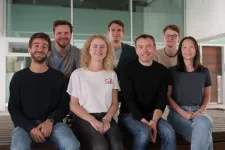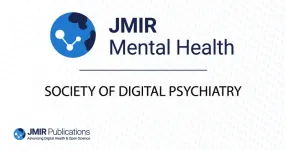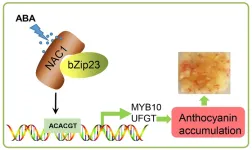(Press-News.org) URBANA, Ill. – As Corn Belt states seek ways to curb nitrogen flow from farms into the Gulf of Mexico, new University of Illinois research adds evidence for winter cover crops as an important part of the solution. A simulation study published in Science of the Total Environment finds widespread planting of cereal rye in Illinois could reduce nitrate in the state’s tile drainage water by 30%.
The research team, part of the College of Agricultural, Consumer and Environmental Sciences (ACES) and The Grainger College of Engineering at Illinois, knew from small-scale studies that cover crops are capable of sucking nitrate out of soil water, with long-lasting effects throughout the growing season. Their new study is the first to estimate cereal rye’s potential on a statewide level.
The team simulated both cover crop planting (yes or no) and fertilizer timing (fall or spring) under real climatic conditions in Illinois between 2001 and 2020. They used a crop simulation model known as Decision Support System for Agrotechnology Transfer (DSSAT), which allows multi-year growth projections for more than 42 crops. Although cereal rye wasn’t among them, the researchers adapted the model’s parameters for winter wheat, the most similar crop in DSSAT.
“Two management implications were revealed in this paper. One is that farmers should apply a winter cover crop, such as cereal rye, to reduce tile water flow and nitrate loss by 25 and 30%, respectively. Our data also reinforced that farmers should switch to spring fertilization, if possible. We compared spring versus fall fertilization with and without the cover crop, and fall was worse for nitrate loss in both scenarios,” says study co-author Rabin Bhattarai, associate professor in the Department of Agricultural and Biological Engineering, a shared unit of ACES and Grainger.
The model also simulated cover crop effects on cash crop yield and found, overall, that cereal rye had a slight positive impact on corn and soybean under both fertilization schedules. Bhattarai says there was some variation among years and locations across the state, but over the 20-year simulation, there was no evidence of a yield penalty.
Cover crop adoption remains low in Illinois and the Midwest despite the availability of cost-sharing programs and growing evidence touting benefits to soil health, water quality, and more.
“Our research shows cover crops work,” Bhattarai says. “They have the potential to reduce erosion as well as nutrient loss from our fields, especially with tile drainage. We wanted to explore the benefits on the whole-state level to show what could happen if thousands of farmers adopted this conservation practice simultaneously,” he says. “The water quality benefits would be significant.”
No simulation model is perfect, and Bhattarai’s struggled a little in the hillier southern section of Illinois. But when compared with real-world corn and soybean yields, the yields forecast by the model were a close match, suggesting the model was likely accurate overall.
Early phases of the project began with small-scale field experiments to understand cover crop and fertilizer timing effects on nitrate loss in tile and runoff water. These early experiments were used to develop the modified DSSAT model capable of scaling up to the entire state. They also informed an online decision-support tool, funded by the Illinois Nutrient Research and Education Council, for farmers considering cover crops in their own fields.
“Using our dashboard, farmers can get simulated results of cereal rye growing as a cover crop in their actual fields. At different dates within a two-week window of expected planting for the cash crop, farmers can compare potential biomass in the field, C:N ratio in that biomass, nitrogen uptake, and nitrogen loss reduction. To improve results further, farmers can provide more specific information for their fields, including cropping history and management programs,” says co-author Jonathan Coppess, associate professor in the Department of Agricultural and Consumer Economics in ACES.
A full article on the tool was published in farmdoc.
The article, “Evaluation of long-term impact of cereal rye as a winter cover crop in Illinois,” is published in Science of the Total Environment [DOI: 10.1016/j.scitotenv.2023.162956]. Additional authors include Rishabh Gupta, Prasanta Kalita, Hamze Dokoohaki, and Shalamar Armstrong. Funding for the project came from the Illinois Nutrient Research and Education Council and USDA National Institute of Food and Agriculture. The work made use of the Illinois Campus Cluster Program in conjunction with the National Center for Supercomputing Applications, funded by the University of Illinois.
END
Winter cover crops could reduce nitrogen in Illinois drainage water by 30%
2023-04-24
ELSE PRESS RELEASES FROM THIS DATE:
Mount Sinai launches Institute for Regenerative Medicine
2023-04-24
Regenerative medicine—the process of replacing, engineering or regenerating human cells, tissues or organs—holds exciting potential for the field of health care. It could someday make it possible to grow a new kidney in a petri dish, repair damaged nerve cells, or reverse memory loss.
Continuing a commitment to advance medicine through forward-thinking approaches and groundbreaking discoveries, the Icahn School of Medicine at Mount Sinai is announcing the creation of the Institute for Regenerative Medicine to foster innovative research into new pathways to cure ...
Researchers team up with national lab for innovative look at copper reactions
2023-04-24
BINGHAMTON, N.Y. -- Researchers at Binghamton University partnered with the Center for Functional Nanomaterials (CFN) — a U.S. Department of Energy Office of Science User Facility at Brookhaven National Laboratory — to get a better look at how peroxides on the surface of copper oxide promote the oxidation of hydrogen but inhibit the oxidation of carbon monoxide, allowing them to steer oxidation reactions.
They were able to observe these quick changes with two complimentary spectroscopy methods that have not been used in this way. The results of this work have been published in the journal Proceedings ...
New report provides insight into the library’s evolving role in student success
2023-04-24
A new Technology from Sage report sheds light on challenges in the librarian-patron relationship, including the need for greater digital literacy and more tailored support for students, and recommends methods to support the student experience. “The Knowledge Gap Between Librarians and Students: Contrasting Librarian and Student Perspectives on the Undergraduate Workflow” report is the second in the Librarian Futures series.
A survey of nearly 600 students in the US, UK, and Canada highlights key findings for librarians across the undergraduate workflow — specifically ...
Understanding the long-term impact of climate change on Indian crops
2023-04-24
Over the past few decades, it has become obvious that climate change, and consequent extreme weather events, can wreak havoc on crop yields. Concerningly, there is a large disparity in agricultural vulnerability between developed and developing countries. In a new study, researchers have looked at major food grains in India to understand the long- and short-term effects of climate change on crop yields.
“Most studies that measure the effects of climate change are looking at year-to-year changes, which are representative of variations in weather and not climate,” said Madhu Khanna (CABBI), a professor of agriculture ...
New machine learning framework for more accurate plant disease diagnosis
2023-04-24
Plant diseases pose a significant threat to nations across the globe, owing to the financial burden they impose and the impact they have on food security. Healthy crops sustain millions of livelihoods, and accurate diagnosis of plant diseases allows for timely interventions to ensure sufficient crop production with minimal yield loss. Traditional approaches to disease recognition typically follow two paths. The first relies on crop inspection by trained experts, while the second leverages neural networks ...
Differentiation landscape of acute myeloid leukemia charted with new tool
2023-04-24
Researchers have developed a new method to distinguish between cancerous and healthy stem cells and progenitor cells from samples of patients with acute myeloid leukaemia (AML), a disease driven by malignant blood stem cells that have historically been difficult to identify. The findings, published today in the journal Cell Stem Cell, pave the way for the development of new techniques to predict whether patients will respond to chemotherapy.
AML is a type of cancer characterised by the rapid growth and accumulation of abnormal white blood cells. ...
Sanghera receives funding for pilot project
2023-04-24
Kamaljeet Sanghera, Executive Director, Institute for Digital InnovAtion (IDIA), Research and Innovation Initiatives; Professor, Information Sciences and Technology, received funding to design and deliver a pilot of a summer, hands-on experience for 20 high school students.
Sanghera will leverage IBM artificial intelligence (AI) kits to help the students gain technical skills, knowledge, and abilities in AI and an understanding of its ethical and social impact.
Sanghera received $150,000 from Trenchant Analytics, LLC, on a subaward from the ...
JMIR Publications and Society of Digital Psychiatry partner to advance digital mental health research
2023-04-24
(Toronto, April 24, 2023) JMIR Publications and the Society of Digital Psychiatry (SODP) have announced a new partnership aimed at advancing research in the field of digital mental health. This collaboration will focus on supporting education and knowledge sharing in the fast moving world of digital psychiatry and establishing priorities for the space, including identifying current gaps in knowledge and determining areas for future study, with particular emphasis on addressing disparities in access to care.
The partnership brings together JMIR Publications, a leading open-access publisher of scholarly journals on digital health, ...
The ABA-induced NAC transcription factor MdNAC1 interacts with a bZIP-type transcription factor to promote anthocyanin synthesis in red-fleshed apples
2023-04-24
Exploring the upstream transcription factors or proteins interacting with MdMYB10 is an important way to enrich the complex network of anthocyanin synthesis. In this study, the upstream regulatory gene MdNAC1 of MdMYB10 was selected through yeast one hybridization experiments, and EMSA and LUC experiments showed that MdNAC1 can transcriptionally activate MdMYB10. The transformation experiments in apple callus and apple fruit showed that MdNAC1 significantly promoted the accumulation of anthocyanins. At the same time, researchers have found that MdNAC1 can interact with MdbZIP23 ...
Problems with ‘pruning’ brain connections linked to adolescent mental health disorders
2023-04-24
Problems with the brain’s ability to ‘prune’ itself of unnecessary connections may underlie a wide range of mental health disorders that begin during adolescence, according to research published today.
The findings, from an international collaboration, led by researchers in the UK, China and Germany, may help explain why people are often affected by more than one mental health disorder, and may in future help identify those at greatest risk.
One in seven adolescents (aged 10-19 years old) worldwide experiences mental health disorders, according to the World Health Organization (WHO). Depression, anxiety and behavioural disorders, such as ...





